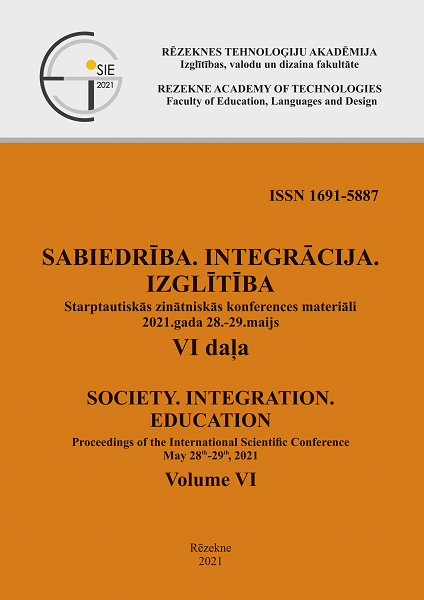TRAINING IN MEDIATION: APPLICATION ON THE COMMUNICATION MODEL
DOI:
https://doi.org/10.17770/sie2021vol6.6347Keywords:
communication, sign, construct, questionnaire, communication noise, teaching a dialogue.Abstract
Teaching the participants of the conflict to conduct a communication is an important process in the mediation. A positive result of the mediation, i.e., resolution of the conflict, is impossible without teaching the participants the rules of a conflict-free communication; that will allow them to avoid conflict situations in society also in future. The publication considers a model of communication between the participants in the conflict as well as the mediator. The model is built on the basis of an analysis of the principles of existing communication models and experience of a practicing mediator. The types of communication noises (including constructs as communication barriers) have been identified and classified, and techniques for detecting these noises has been proposed. By selecting and studying them the mediator has the opportunity to effectively arrange a training for the participants of the conflict. The objective of the study is to build a communication model in a mediation, taking into account semantic and psychological noises; to demonstrate the role of a mediator in a constructive conflict resolution for dialogue teaching; to determine the mediator’s tools. The theoretical study is based on the analysis and assessment of philosophical, pedagogical and psychological literature and a mediation practice. Results: a model of communication in the process of mediation, questionnaire for identifying noises and a processing algorithm for it to determine the methodology for teaching communication to the participants of the conflict.
Downloads
References
Buber, M. (1995). Dva obraza very. Izd-vo “Respublika.” Retrieved from http://yakov.works/library/02_b/ub/er_00.htm
ECO PARTNERS. (2014). Metodiskais materiāls “Apmācību programma „Zinu! Protu! Varu! Iemaņas veiksmīgai saskarsmei”. Retrieved from https://www.sif.gov.lv/nodevumi/nodevumi/5983/Metodiskais_materials_Eco_partners.pdf
Habermas, J. (2001). Vovlechenie drugogo. Ocherki politicheskoj teorii. Sankt-Peterburg: Nauka. Retrieved from https://vk.com/doc4605748_467697100
Jeko, U. (1968). Otsutstvujushhaja struktura. Vvedenie v semiologiju. TOO TK “Petropolis.” Retrieved from https://studfile.net/preview/5267540/
Kelli, D. (2000). Teorija lichnosti (teorija lichnyh konstruktov). Retrieved from http://iakovlev.org/zip/kelly.pdf
Kelly, G. (1991). The psychology of personal constructs. Routledge in association with the Centre for Personal Construct Psychology.
Luman, N. (1995). Сhto takoe kommunikacija, 114–125. Retrieved from https://gtmarket.ru/library/articles/2954
Peirce, C. S. (2008). The Collected Papers of Charles Sanders Peirce. Retrieved from https://colorysemiotica.files.wordpress.com/2014/08/peirce-collectedpapers.pdf
Portere, V., & Briede, B. (2019). Importance of Dialogue Nature in the Mediator’s Competence. ENVIRONMENT. EDUCATION. PERSONALITY, 12, 146–151. https://doi.org/10.22616/REEP.2019.018
Portere, V., & Morevs, V. (2020a). Constructivism in Mediation. In ENVIRONMENT. EDUCATION. PERSONALITY, Vol. 13, 258–265). https://doi.org/10.22616/REEP.2020.031
Portere, V., & Morevs, V. (2020b). DIALOGUE IS A SIGN OF CONSTRUCTIVENESS IN MEDIATION. RESEARCH FOR RURAL DEVELOPMENT 2020, 35, 296–302. https://doi.org/10.22616/rrd.26.2020.043
Schramm, W. (2018). The Nature of Communication between Humans. Retrieved from https://marketing-course.ru/wp-content/uploads/2018/11/schramm.pdf
Shannon, C. E. (1998). Communication in the Presence of Noice. Proceeding of the IEEE, 86(2), 447–457. Retrieved from https://web.archive.org/web/20100208112344/http:/www.stanford.edu/class/ee104/shannonpaper.pdf
Vaclavik, P., Bivin, D., & Dzhekson, D. (2000). Psihologija mezhlichnostnyh kommunikacij. Sankt-Peterburg: Rech’.
Viner, N. (1983). Kibernetika, ili Upravlenie i svjaz’ v zhivotnom i mashine. Maskva. Retrieved from http://grachev62.narod.ru/cybern/contents.htm


